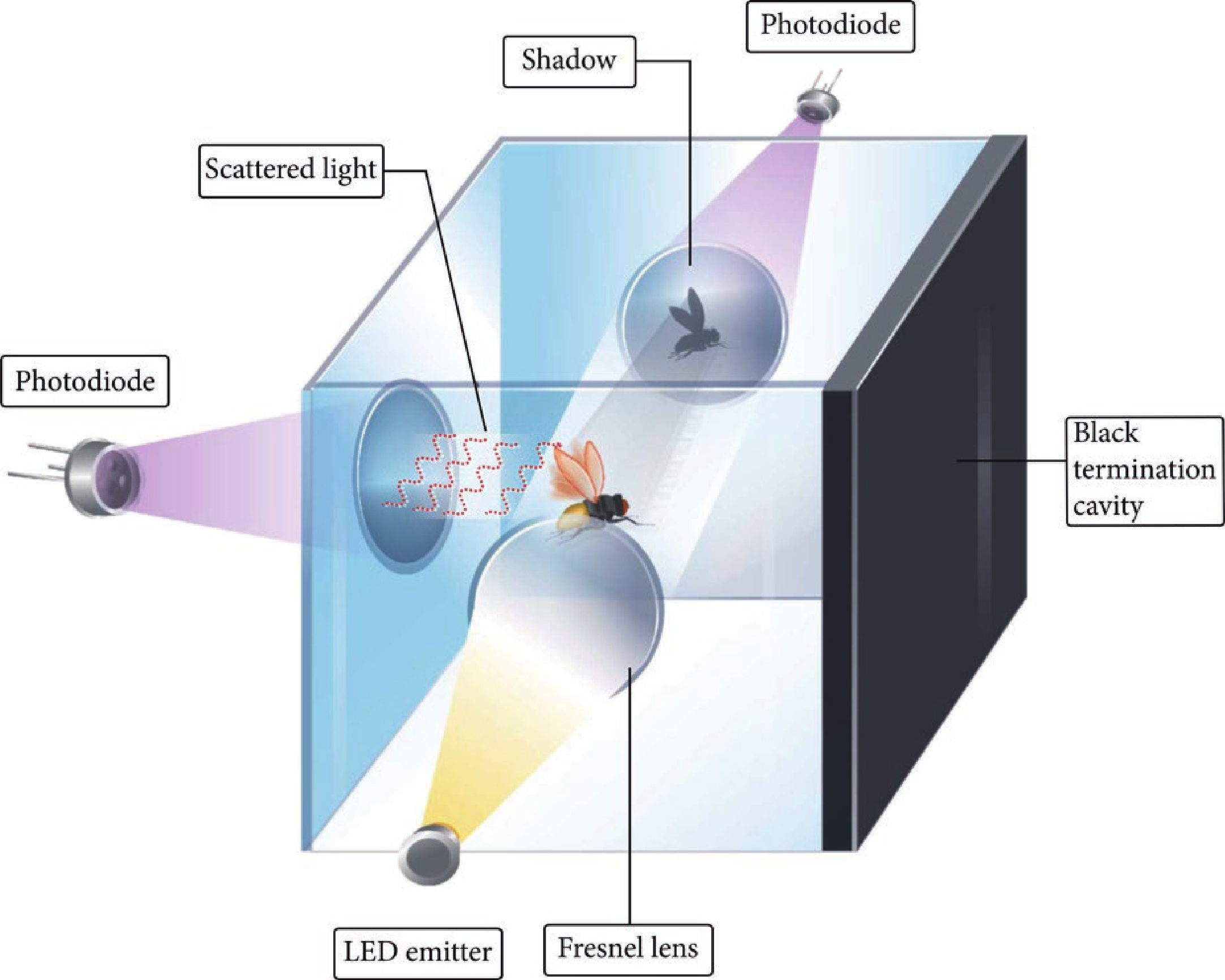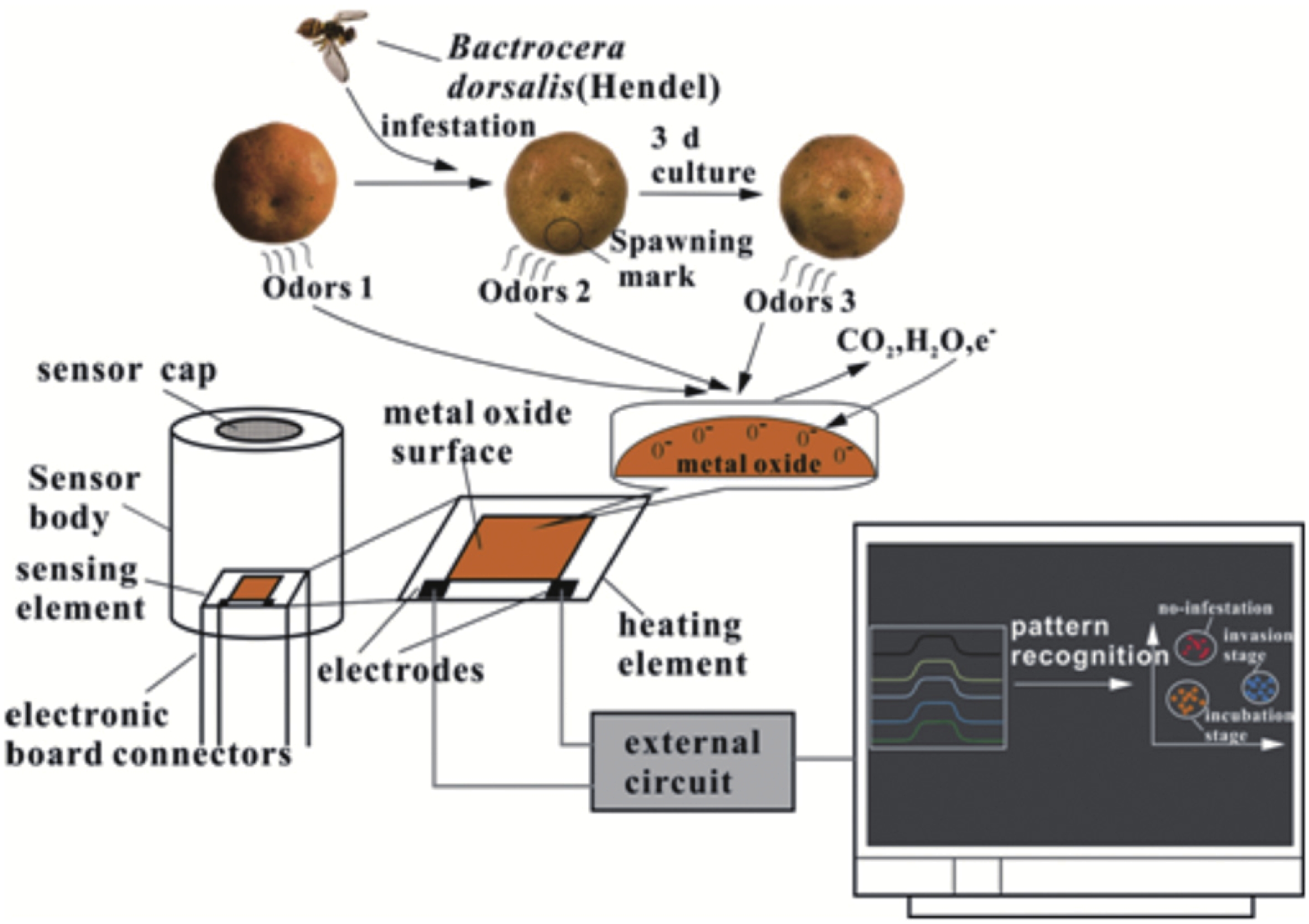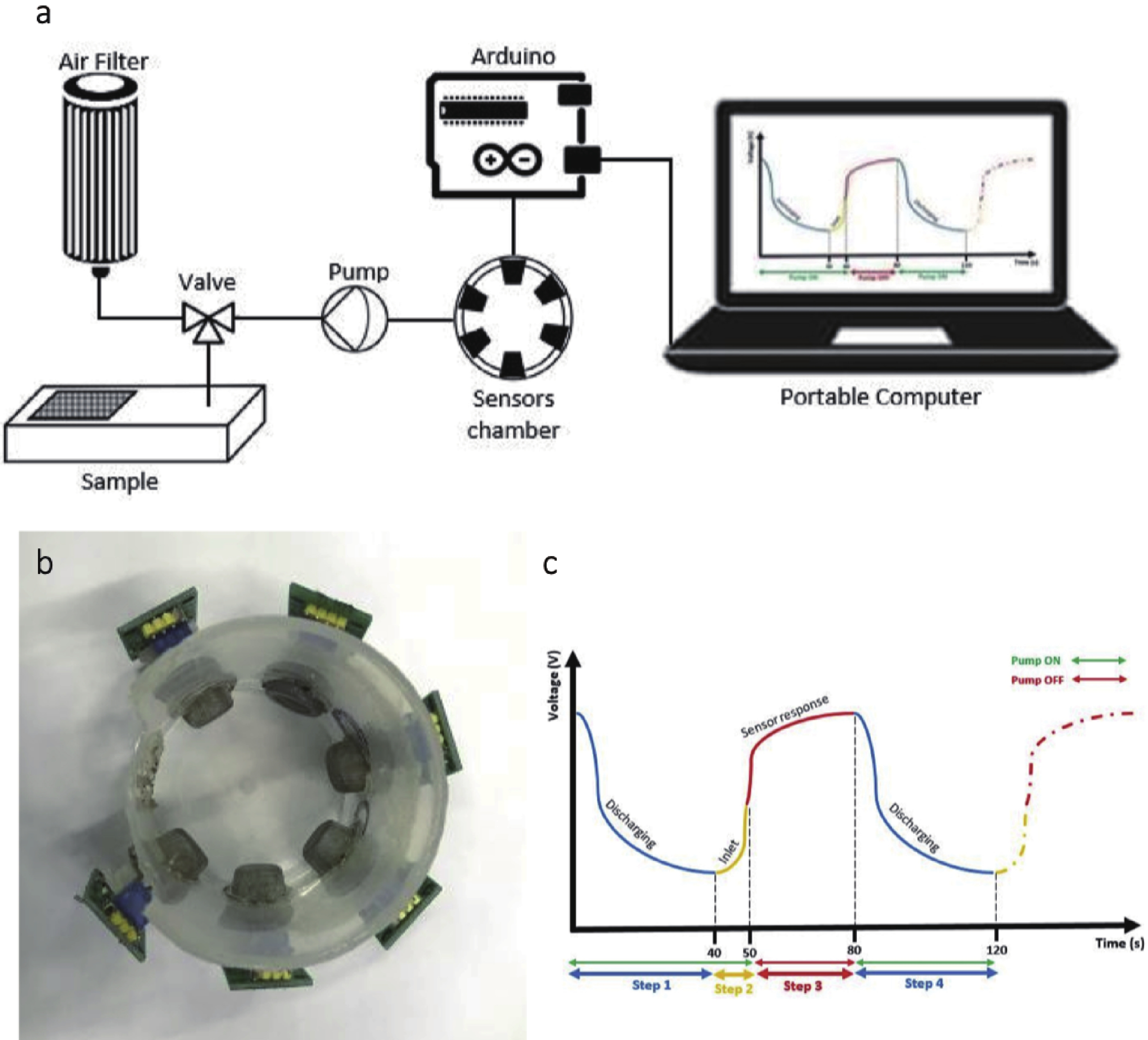| Citation: |
Jiayao He, Ke Chen, Xubin Pan, Junfeng Zhai, Xiangmei Lin. Advanced biosensing technologies for monitoring of agriculture pests and diseases: A review[J]. Journal of Semiconductors, 2023, 44(2): 023104. doi: 10.1088/1674-4926/44/2/023104
****
J Y He, K Chen, X B Pan, J F Zhai, X M Lin. Advanced biosensing technologies for monitoring of agriculture pests and diseases: A review[J]. J. Semicond, 2023, 44(2): 023104. doi: 10.1088/1674-4926/44/2/023104
|
Advanced biosensing technologies for monitoring of agriculture pests and diseases: A review
DOI: 10.1088/1674-4926/44/2/023104
More Information
-
Abstract
The threat posed to crop production by pests and diseases is one of the key factors that could reduce global food security. Early detection is of critical importance to make accurate predictions, optimize control strategies and prevent crop losses. Recent technological advancements highlight the opportunity to revolutionize monitoring of pests and diseases. Biosensing methodologies offer potential solutions for real-time and automated monitoring, which allow advancements in early and accurate detection and thus support sustainable crop protection. Herein, advanced biosensing technologies for pests and diseases monitoring, including image-based technologies, electronic noses, and wearable sensing methods are presented. Besides, challenges and future perspectives for widespread adoption of these technologies are discussed. Moreover, we believe it is necessary to integrate technologies through interdisciplinary cooperation for further exploration, which may provide unlimited possibilities for innovations and applications of agriculture monitoring.-
Keywords:
- precision agriculture,
- biosensors,
- crops,
- disease and pest management
-
References
[1] Unnevehr L J. Causes of and constraints to agricultural and economic development: Discussion. Am J Agric Econ, 2007, 89, 1168 doi: 10.1111/j.1467-8276.2007.01078.x[2] Savary S, Willocquet L, Pethybridge S J, et al. The global burden of pathogens and pests on major food crops. Nat Ecol Evol, 2019, 3, 430 doi: 10.1038/s41559-018-0793-y[3] Strange R N, Scott P R. Plant disease: A threat to global food security. Annu Rev Phytopathol, 2005, 43, 83 doi: 10.1146/annurev.phyto.43.113004.133839[4] Preti M, Verheggen F, Angeli S. Insect pest monitoring with camera-equipped traps: Strengths and limitations. J Pest Sci, 2021, 94, 203 doi: 10.1007/s10340-020-01309-4[5] Weersink A, Fraser E, Pannell D, et al. Opportunities and challenges for big data in agricultural and environmental analysis. Annu Rev Resour Econ, 2018, 10, 19 doi: 10.1146/annurev-resource-100516-053654[6] Silva G, Tomlinson J, Onkokesung N, et al. Plant pest surveillance: From satellites to molecules. Emerg Top Life Sci, 2021, 5, 275 doi: 10.1042/ETLS20200300[7] Walter A, Finger R, Huber R, et al. Opinion: Smart farming is key to developing sustainable agriculture. Proc Natl Acad Sci USA, 2017, 114, 6148 doi: 10.1073/pnas.1707462114[8] Garnett T, Appleby M C, Balmford A, et al. Agriculture. Sustainable intensification in agriculture: Premises and policies. Science, 2013, 341, 33 doi: 10.1126/science.1234485[9] Stafford J V. Implementing precision agriculture in the 21st century. J Agric Eng Res, 2000, 76, 267 doi: 10.1006/jaer.2000.0577[10] Kashyap B, Kumar R. Sensing methodologies in agriculture for monitoring biotic stress in plants due to pathogens and pests. Inventions, 2021, 6, 29 doi: 10.3390/inventions6020029[11] Lee G, Wei Q S, Zhu Y. Emerging wearable sensors for plant health monitoring. Adv Funct Mater, 2021, 31, 2106475 doi: 10.1002/adfm.202106475[12] He D C, Zhan J S, Xie L H. Problems, challenges and future of plant disease management: From an ecological point of view. J Integr Agric, 2016, 15, 705 doi: 10.1016/S2095-3119(15)61300-4[13] Rossi V, Giosuè S, Caffi T. Modelling plant diseases for decision making in crop protection. Precision Crop Protection - the Challenge and Use of Heterogeneity. Dordrecht: Springer Netherlands, 2010, 241[14] Grünig M, Razavi E, Calanca P, et al. Applying deep neural networks to predict incidence and phenology of plant pests and diseases. Ecosphere, 2021, 12, e03791 doi: 10.1002/ecs2.3791[15] Cordier T, Forster D, Dufresne Y, et al. Supervised machine learning outperforms taxonomy-based environmental DNA metabarcoding applied to biomonitoring. Mol Ecol Resour, 2018, 18, 1381 doi: 10.1111/1755-0998.12926[16] van Klink R, August T, Bas Y, et al. Emerging technologies revolutionise insect ecology and monitoring. Trends Ecol Evol, 2022, 37, 872 doi: 10.1016/j.tree.2022.06.001[17] Mahlein A K. Plant disease detection by imaging sensors - parallels and specific demands for precision agriculture and plant phenotyping. Plant Dis, 2016, 100, 241 doi: 10.1094/PDIS-03-15-0340-FE[18] Zhang J C, Huang Y B, Pu R L, et al. Monitoring plant diseases and pests through remote sensing technology: A review. Comput Electron Agric, 2019, 165, 104943 doi: 10.1016/j.compag.2019.104943[19] Ennouri K, Kallel A. Remote sensing: An advanced technique for crop condition assessment. Math Probl Eng, 2019, 2019, 1 doi: 10.1155/2019/9404565[20] Mahlein A K, Kuska M T, Thomas S, et al. Plant disease detection by hyperspectral imaging: From the lab to the field. Adv Animal Biosci, 2017, 8, 238 doi: 10.1017/S2040470017001248[21] Carlos M O J, María H C L, Veronica B F. Detection of significant wavelengths for identifying and classifying Fusarium oxysporum during the incubation period and water stress in Solanum lycopersicum plants using reflectance spectroscopy. J Plant Prot Res, 2019, 59, 244 doi: 10.24425/jppr.2019.129290[22] do Prado Ribeiro L, Klock A L S, Filho J A W, et al. Hyperspectral imaging to characterize plant-plant communication in response to insect herbivory. Plant Methods, 2018, 14, 54 doi: 10.1186/s13007-018-0322-7[23] Eliopoulos P A, Potamitis I, Kontodimas D Ch, et al. Detection of adult beetles inside the stored wheat mass based on their acoustic emissions. J Econ Entomol, 2015, 108, 2808 doi: 10.1093/jee/tov231[24] Holguin G A, Lehman B L, Hull L A, et al. Electronic traps for automated monitoring of insect populations. IFAC Proc Vol, 2010, 43, 49 doi: 10.3182/20101206-3-JP-3009.00008[25] Shaked B, Amore A, Ioannou C, et al. Electronic traps for detection and population monitoring of adult fruit flies (Diptera: Tephritidae). J Appl Entomol, 2018, 142, 43 doi: 10.1111/jen.12422[26] Ding W G, Taylor G. Automatic moth detection from trap images for pest management. Comput Electron Agric, 2016, 123, 17 doi: 10.1016/j.compag.2016.02.003[27] Welsh T J, Bentall D, Kwon C, et al. Automated surveillance of lepidopteran pests with smart optoelectronic sensor traps. Sustainability, 2022, 14, 9577 doi: 10.3390/su14159577[28] Potamitis I, Rigakis I, Vidakis N, et al. Affordable bimodal optical sensors to spread the use of automated insect monitoring. J Sens, 2018, 2018, 1 doi: 10.1155/2018/3949415[29] Maffei M E. Sites of synthesis, biochemistry and functional role of plant volatiles. S Afr N J Bot, 2010, 76, 612 doi: 10.1016/j.sajb.2010.03.003[30] Xu S, Zhou Z Y, Li K L, et al. Recognition of the duration and prediction of insect prevalence of stored rough rice infested by the red flour beetle (tribolium castaneum herbst) using an electronic nose. Sensors, 2017, 17, 688 doi: 10.3390/s17040688[31] Nouri B, Fotouhi K, Mohtasebi S S, et al. Detection of different densities of Ephestia kuehniella pest on white flour at different larvae instar by an electronic nose system. J Stored Prod Res, 2019, 84, 101522 doi: 10.1016/j.jspr.2019.101522[32] Rutolo M F, Iliescu D, Clarkson J P, et al. Early identification of potato storage disease using an array of metal-oxide based gas sensors. Postharvest Biol Technol, 2016, 116, 50 doi: 10.1016/j.postharvbio.2015.12.028[33] Labanska M, Jenkins S, Van Amsterdam S, et al. Detection of the fungal infection in post-harvest Onions by an electronic nose. 2022 IEEE International Symposium on Olfaction and Electronic Nose, 2022, 1 doi: 10.1109/ISOEN54820.2022.9789676[34] Chang K P P, Zakaria A, Abdul Nasir A S, et al. Analysis and feasibility study of plant disease using e-nose. 2014 IEEE International Conference on Control System, Computing and Engineering, 2015, 58 doi: 10.1109/ICCSCE.2014.7072689[35] Hazarika S, Choudhury R, Montazer B, et al. Detection of citrus tristeza virus in mandarin orange using a custom-developed electronic nose system. IEEE Trans Instrum Meas, 2020, 69, 9010 doi: 10.1109/TIM.2020.2997064[36] Srivastava S, Mishra G, Mishra H N. Fuzzy controller based E-nose classification of Sitophilus oryzae infestation in stored rice grain. Food Chem, 2019, 283, 604 doi: 10.1016/j.foodchem.2019.01.076[37] Cellini A, Blasioli S, Biondi E, et al. Potential applications and limitations of electronic nose devices for plant disease diagnosis. Sensors, 2017, 17, 2596 doi: 10.3390/s17112596[38] Zheng Z C, Zhang C. Electronic noses based on metal oxide semiconductor sensors for detecting crop diseases and insect pests. Comput Electron Agric, 2022, 197, 106988 doi: 10.1016/j.compag.2022.106988[39] Wen T, Zheng L Z, Dong S, et al. Rapid detection and classification of citrus fruits infestation by Bactrocera dorsalis (Hendel) based on electronic nose. Postharvest Biol Technol, 2019, 147, 156 doi: 10.1016/j.postharvbio.2018.09.017[40] Lampson B D, Han Y J, Khalilian A, et al. Development of a portable electronic nose for detection of pests and plant damage. Comput Electron Agric, 2014, 108, 87 doi: 10.1016/j.compag.2014.07.002[41] Biondi E, Blasioli S, Galeone A, et al. Detection of potato brown rot and ring rot by electronic nose: From laboratory to real scale. Talanta, 2014, 129, 422 doi: 10.1016/j.talanta.2014.04.057[42] Schroeder V, Savagatrup S, He M, et al. Carbon nanotube chemical sensors. Chem Rev, 2019, 119, 599 doi: 10.1021/acs.chemrev.8b00340[43] Cardoso R M, Pereira T S, Facure M H M, et al. Current progress in plant pathogen detection enabled by nanomaterials-based (bio)sensors. Sens Actuat Rep, 2022, 4, 100068 doi: 10.1016/j.snr.2021.100068[44] Rabti A, Raouafi N, Merkoçi A. Bio(Sensing) devices based on ferrocene-functionalized graphene and carbon nanotubes. Carbon, 2016, 108, 481 doi: 10.1016/j.carbon.2016.07.043[45] Onthath H, Maurya M R, Bykkam S, et al. Development and fabrication of carbon nanotube (CNT)/CuO nanocomposite for volatile organic compounds (VOCs) gas sensor application. Macromol Symp, 2022, 402, 2270202 doi: 10.1002/masy.202270202[46] Greenshields M W C C, Mamo M A, Coville N J, et al. Tristimulus mathematical treatment application for monitoring fungi infestation evolution in melon using the electrical response of carbon nanostructure-polymer composite based sensors. Sens Actuat B, 2013, 188, 378 doi: 10.1016/j.snb.2013.07.014[47] Greenshields M W C C, Cunha B B, Coville N J, et al. Fungi active microbial metabolism detection of rhizopus sp. and aspergillus sp. section nigri on strawberry using a set of chemical sensors based on carbon nanostructures. Chemosensors, 2016, 4, 19 doi: 10.3390/chemosensors4030019[48] Zhao D, Zhao B Y, Koltsov D, et al. Detection of VOCs and nitrogen containing gaseous molecules by utilizing carbon nanotubes (CNTs) as sensing materials. Meet Abstr, 2022, 2629 doi: 10.1149/MA2022-02632629mtgabs[49] Verma M S, Wei S C, Rogowski J L, et al. Interactions between bacterial surface and nanoparticles govern the performance of “chemical nose” biosensors. Biosens Bioelectron, 2016, 83, 115 doi: 10.1016/j.bios.2016.04.024[50] Kim J S, Yoo H W, Choi H O, et al. Tunable volatile organic compounds sensor by using thiolated ligand conjugation on MoS2. Nano Lett, 2014, 14, 5941 doi: 10.1021/nl502906a[51] Moitra P, Bhagat D, Kamble V B, et al. First example of engineered β-cyclodextrinylated MEMS devices for volatile pheromone sensing of olive fruit pests. Biosens Bioelectron, 2021, 173, 112728 doi: 10.1016/j.bios.2020.112728[52] Zheng Y Q, Wang Y W, Li Z X, et al. MXene quantum dots/perovskite heterostructure enabling highly specific ultraviolet detection for skin prevention. Matter, 2023, 6, 506 doi: 10.1016/j.matt.2022.11.020[53] Chai Y F, Chen C Y, Luo X, et al. Cohabiting plant-wearable sensor in situ monitors water transport in plant. Adv Sci, 2021, 8, 2003642 doi: 10.1002/advs.202003642[54] Giraldo J P, Wu H H, Newkirk G M, et al. Nanobiotechnology approaches for engineering smart plant sensors. Nat Nanotechnol, 2019, 14, 541 doi: 10.1038/s41565-019-0470-6[55] Liu J. Smart-agriculture: wearable devices for plant protection. In: Wearable Physical, Chemical and Biological Sensors. Amsterdam: Elsevier, 2022 doi: 10.1016/B978-0-12-821661-3.00002-1[56] Nezhad A S. Future of portable devices for plant pathogen diagnosis. Lab Chip, 2014, 14, 2887 doi: 10.1039/C4LC00487F[57] Dong K R, Wang Y C, Zhang R P, et al. Flexible and shape-morphing plant sensors designed for microenvironment temperature monitoring of irregular surfaces. Adv Mater Technol, 2022, 2201204 doi: 10.1002/admt.202201204[58] Lu Y Y, Yang G, Shen Y J, et al. Multifunctional flexible humidity sensor systems towards noncontact wearable electronics. Nanomicro Lett, 2022, 14, 150 doi: 10.1007/s40820-022-00895-5[59] Lan L Y, Le X H, Dong H Y, et al. One-step and large-scale fabrication of flexible and wearable humidity sensor based on laser-induced graphene for real-time tracking of plant transpiration at bio-interface. Biosens Bioelectron, 2020, 165, 112360 doi: 10.1016/j.bios.2020.112360[60] Oren S, Ceylan H, Schnable P S, et al. Wearable electronics: High-resolution patterning and transferring of graphene-based nanomaterials onto tape toward roll-to-roll production of tape-based wearable sensors. Adv Mater Technol, 2017, 2, 1770055 doi: 10.1002/admt.201770055[61] Li L L, Zhao S F, Ran W H, et al. Dual sensing signal decoupling based on tellurium anisotropy for VR interaction and neuro-reflex system application. Nat Commun, 2022, 13, 5975 doi: 10.1038/s41467-022-33716-9[62] Lu Y Y, Xu K C, Zhang L S, et al. Multimodal plant healthcare flexible sensor system. ACS Nano, 2020, 14, 10966 doi: 10.1021/acsnano.0c03757[63] Khan S M, Shaikh S F, Qaiser N, et al. Flexible lightweight CMOS-enabled multisensory platform for plant microclimate monitoring. IEEE Trans Electron Devices, 2018, 65, 5038 doi: 10.1109/TED.2018.2872401[64] Nassar J M, Khan S M, Villalva D R, et al. Compliant plant wearables for localized microclimate and plant growth monitoring. Npj Flex Electron, 2018, 2, 24 doi: 10.1038/s41528-018-0039-8[65] Lee K, Park J, Lee M S, et al. In-situ synthesis of carbon nanotube-graphite electronic devices and their integrations onto surfaces of live plants and insects. Nano Lett, 2014, 14, 2647 doi: 10.1021/nl500513n[66] Li Z, Liu Y X, Hossain O, et al. Real-time monitoring of plant stresses via chemiresistive profiling of leaf volatiles by a wearable sensor. Matter, 2021, 4, 2553 doi: 10.1016/j.matt.2021.06.009[67] Zhang Y M, Cao J M, Yuan Z Y, et al. TiVCTx MXene/chalcogenide heterostructure-based high-performance magnesium-ion battery as flexible integrated units. Small, 2022, 18, 2202313 doi: 10.1002/smll.202202313[68] Høye T T, Ärje J, Bjerge K, et al. Deep learning and computer vision will transform entomology. Proc Natl Acad Sci USA, 2021, 118, e2002545117 doi: 10.1073/pnas.2002545117[69] Galieni A, D'Ascenzo N, Stagnari F, et al. Past and future of plant stress detection: An overview from remote sensing to positron emission tomography. Front Plant Sci, 2021, 11, 609155 doi: 10.3389/fpls.2020.609155[70] Barbedo J. A review on the use of unmanned aerial vehicles and imaging sensors for monitoring and assessing plant stresses. Drones, 2019, 3, 40 doi: 10.3390/drones3020040[71] Roosjen P P, Kellenberger B, Kooistra L, et al. Deep learning for automated detection of Drosophila suzukii: Potential for UAV-based monitoring. Pest Manag Sci, 2020, 76, 2994 doi: 10.1002/ps.5845[72] Shanmugapriya P, Rathika S, Ramesh T, et al. Applications of remote sensing in agriculture - A review. Int J Curr Microbiol App Sci, 2019, 8, 2270 doi: 10.20546/ijcmas.2019.801.238[73] Bietresato M, Carabin G, D'Auria D, et al. A tracked mobile robotic lab for monitoring the plants volume and health. 2016 12th IEEE/ASME International Conference on Mechatronic and Embedded Systems and Applications, 2016, 1 doi: 10.1109/MESA.2016.7587134[74] Hu Z H, Liu B Y, Zhao Y C. Agricultural robot for intelligent detection of Pyralidae insects. Agricultural Robots - Fundamentals and Applications. London: IntechOpen, 2019 doi: 10.5772/intechopen.79460[75] Zhao S F, Ran W H, Lou Z, et al. Neuromorphic-computing-based adaptive learning using ion dynamics in flexible energy storage devices. Natl Sci Rev, 2022, 9, nwac158 doi: 10.1093/nsr/nwac158[76] Potamitis I, Eliopoulos P, Rigakis I. Automated remote insect surveillance at a global scale and the Internet of Things. Robotics, 2017, 6, 19 doi: 10.3390/robotics6030019[77] Chettri L, Bera R. A comprehensive survey on Internet of Things (IoT) toward 5G wireless systems. IEEE Internet Things J, 2020, 7, 16 doi: 10.1109/JIOT.2019.2948888 -
Proportional views






 DownLoad:
DownLoad:













 Jiayao He:focuses on plant protection, pest risk analysis, and monitoring of agriculture pests and diseases
Jiayao He:focuses on plant protection, pest risk analysis, and monitoring of agriculture pests and diseases Junfeng Zhai:got his Doctor’s degree of agricultural biotechnology at Jilin Agricultural University in 2013. His research fields include biotechnology development, biological safety evaluation, and monitoring of agriculture pests and diseases
Junfeng Zhai:got his Doctor’s degree of agricultural biotechnology at Jilin Agricultural University in 2013. His research fields include biotechnology development, biological safety evaluation, and monitoring of agriculture pests and diseases Xiangmei Lin:got her Doctor’s degree of Veterinary Pathology at Nanjing Agricultural University in 1998. Her research interests include detection and monitoring technologies for animal diseases, zoonotic diseases, foreign animal diseases and monitoring technologies for the detection of genetic modification in animals
Xiangmei Lin:got her Doctor’s degree of Veterinary Pathology at Nanjing Agricultural University in 1998. Her research interests include detection and monitoring technologies for animal diseases, zoonotic diseases, foreign animal diseases and monitoring technologies for the detection of genetic modification in animals



